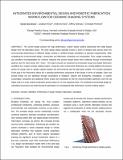| dc.contributor.author | Bechthold, Martin | |
| dc.contributor.author | King, Nathan | |
| dc.contributor.author | Kane, Anthony Owen | |
| dc.contributor.author | Niemasz, Jeffrey | |
| dc.contributor.author | Reinhart, Christoph | |
| dc.date.accessioned | 2014-06-11T20:00:04Z | |
| dc.date.issued | 2011 | |
| dc.identifier | Quick submit: 2014-02-26T10:42:14-05:00 | |
| dc.identifier.citation | Bechthold, Martin, Jonathan King, Anthony Kane, Jeffrey Niemasz, and Christoph Reinhart. 2011. Integrated Environmental Design and Robotic Fabrication Workflow for Ceramic Shading Systems. In 2011 Proceedings of the 28th ISARC, Seoul, Korea, ed. International Association for Automation and Robotics in Construction, 70-75. Seoul, Korea: International Association for Automation and Robotics in Construction. | en_US |
| dc.identifier.uri | http://nrs.harvard.edu/urn-3:HUL.InstRepos:12308165 | |
| dc.description.abstract | The current design practice for high performance, custom facade systems disconnects the initial façade design from the fabrication phase. The early design phases typically involve a series of iterative tests during which the environmental performance of different design variants is verified through simulations or physical measurements. After completing the environmental design, construction and fabrication constraints are incorporated. Time, budget constraints, and workflow incompatibilities are common obstacles that prevent design teams from verifying, through environmental analysis, that the final design still ‘works’. This paper presents an integrated environmental design and digital fabrication workflow for a custom ceramic shading system. Using the CAD environment Rhinoceros as a shared platform the process allows the design team to rapidly migrate between the environmental and the fabrication models. The recently developed DIVA plug-in for Rhinoceros allows for a seamless performance assessment of the facade in terms of daylight. Glare and annual energy use are addressed through connections to Radiance, Daysim and EnergyPlus simulations. A custom Grasshopper component and additional Rhino scripts were developed to link the environmentally optimized CAD file via Rapid code to a novel ceramic production process based on a 6-axis industrial robot. The resulting environmental design-to- manufacturing process was tested during the generation of a prototypical high performance ceramic shading system. | en_US |
| dc.language.iso | en_US | en_US |
| dc.publisher | International Association for Automation and Robotics in Construction | en_US |
| dc.relation.isversionof | http://www.iaarc.org/publications/proceedings_of_the_28th_isarc/integrated_environmental_design_and_robotic_fabrication_workflow_for_ceramic_shading_systems.html | en_US |
| dc.relation.hasversion | http://www.baufachinformation.de/aufsatz.jsp?ul=2012031000258 | en_US |
| dash.license | OAP | |
| dc.subject | Ceramic | en_US |
| dc.subject | Workflow | en_US |
| dc.subject | Performance | en_US |
| dc.subject | Facade | en_US |
| dc.subject | Robotic Fabrication | en_US |
| dc.subject | Simulation | en_US |
| dc.title | Integrated Environmental Design and Robotic Fabrication Workflow for Ceramic Shading Systems | en_US |
| dc.type | Conference Paper | en_US |
| dc.date.updated | 2014-02-26T15:44:01Z | |
| dc.description.version | Version of Record | en_US |
| dc.rights.holder | Martin Bechthold, Jonathan King, Anthony Kane, Jeffrey Niemasz, Christoph Reinhart | |
| dash.depositing.author | Bechthold, Martin | |
| dc.date.available | 2014-06-11T20:00:04Z | |
| dash.contributor.affiliated | Kane, Anthony Owen | |
| dash.contributor.affiliated | King, Nathan | |
| dash.contributor.affiliated | Bechthold, Martin | |


